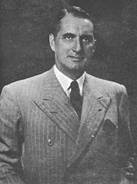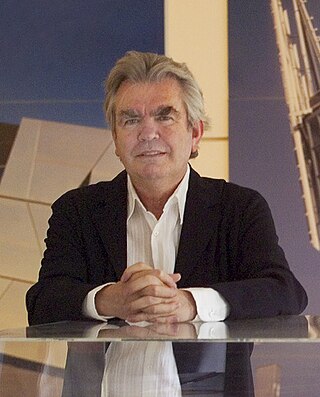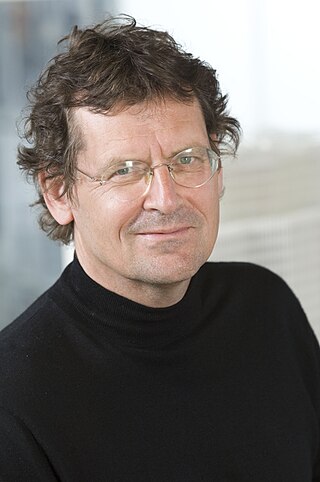
Brindleyplace is a large mixed-use canalside development, in the Westside district of Birmingham, England. It was named after Brindley Place, the name of the street around which it is built. It was developed by the Argent Group from 1993 onwards.

Mailbox Birmingham is a mixed-use development located within the city centre of Birmingham, England. It houses British luxury department store chain Harvey Nichols, and the BBC Birmingham studios.

Harold William "Harry" Weedon was an English architect. Although he designed a large number of buildings during a long career, he is best known for his role overseeing the Art Deco designs of the Odeon Cinemas for Oscar Deutsch in the 1930s. Influenced by the work of Erich Mendelsohn and Hans Poelzig – the Odeons "taught Britain to love modern architecture" and form "a body of work which, with London Underground stations, denotes the Thirties like nothing else".

The Jewellery Quarter is an area of central Birmingham, England, in the north-western area of Birmingham City Centre, with a population of 19,000 in a 1.07-square-kilometre (264-acre) area.
Glenn Paul Howells is a British architect and a director and founder of Howells.

Birmingham city centre, also known as Central Birmingham, is the central business district of Birmingham, England. The area was historically in Warwickshire. Following the removal of the Inner Ring Road, the city centre is now defined as being the area within the Middle Ring Road. The city centre is undergoing massive redevelopment with the Big City Plan, which means there are now nine emerging districts and the city centre is approximately five times bigger.

Lifschutz Davidson Sandilands is a practice of architects, urban designers and masterplanners established in 1986 and practising out of London.

Feilden Clegg Bradley Studios is a British architectural design firm, established in 1978, with offices in Bath, London, Manchester and Belfast. The firm is known for its pioneering work in sustainable design and social design agenda.
Derek James Latham is British architect, urban designer, masterplanner and landscape architect, and founder of Lathams, a Derby-based architectural and urban design practice. He is married to British Member of Parliament Pauline Latham.

Sir Terence Farrell, known as Terry Farrell, is a British architect and urban designer. In 1980, after working for 15 years in partnership with Sir Nicholas Grimshaw, Farrell founded his own firm, Farrells. He established his reputation with three completed projects in London in the late 1980s: Embankment Place, 125 London Wall aka Alban Gate and SIS Building aka Vauxhall Cross.

Page\Park Architects was established in 1981 by David Page and Brian Park. It has developed one of Scotland's best known practices undertaking work over a range of sectors.

CZWG Limited is a British architecture practice established in 1975 by Nick Campbell, Roger Zogolovitch, Rex Wilkinson and Piers Gough. The practice's work includes community and public buildings, residential and mixed use projects, student housing and retail, leisure and workplace uses. The practice is known for its work in the postmodern style.

van Heyningen and Haward is an architectural practice, founded in 1983 by Birkin Haward and Joanna van Heyningen, and now owned and managed by James McCosh and Meryl Townley. The London architects work primarily in education, and have also worked in the heritage, community and health sectors.

Eric Owen Parry is a British architect, designer, writer and educator. Parry is the founder and principal of Eric Parry Architects established in London in 1983. His built work includes the restoration and renewal of St Martin-in-the-Fields in London, the Holburne Museum in Bath, 50 New Bond Street, 23 Savile Row, One Eagle Place in Piccadilly, Aldermanbury Square by London Wall, 30 Finsbury Square in London, and the London Stock Exchange. His projects also include a number of residential developments. Eric Parry's architectural work and design has been shown internationally on major exhibitions, including the Royal Academy of Arts, the British School at Rome, and the 2012 Venice Biennale of Architecture.
Nicholas Hare Architects is a UK architectural practice, with a portfolio of award-winning projects. These include schools, higher education, refurbishment, commercial projects, and buildings for the arts. Founded by Nicholas Hare in 1977, the practice is now a limited liability partnership with over 50 employees. The office is based in an old book-binding factory in Barnsbury Square in Islington. Nicholas Hare Architects LLP is a member of the UK Green Building Council and achieves BREEAM Excellent rating for several of its completed buildings.
Patel Taylor is an architectural practice based in Clerkenwell, London. Placemaking defines its work. It operates from its own studios in Rawstorne Street, in an old warehouse converted by the firm in 2011.
Sergison Bates architects is an architectural practice with an office in London and Zürich. It was founded by Jonathan Sergison and Stephen Bates in 1996 in London. In addition to the two founding partners, their long-standing collaborator Mark Tuff has been a partner of the practice. Sergison Bates architects are best known for their residential buildings but have also realised public and institutional projects in the UK, continental Europe and China. In addition to their work as practising architects both Jonathan Sergison and Stephen Bates have taught architecture at various universities. Jonathan Sergison is a professor at the Accademia di Architettura in Mendrisio, whilst Stephen Bates is Professor and joint head of the Department for Urban Planning and Housing at the Technical University of Munich together with Bruno Krucker. Both architects have written and lectured on a wide range of topics related to architectural design. In 2006 they were awarded the prestigious Heinrich Tessenow Gold Medal and Erich Schelling Medal for their contribution to architecture.

CPMG Architects is an architectural practice in Nottingham.
RIBA National Awards are part of an awards program operated by the Royal Institute of British Architects, also encompassing the Stirling Prize, the European Award and the International Award. The National Awards are given to buildings in the UK which are "recognised as significant contributions to architecture" which are chosen from the buildings to receive an RIBA Regional award.
DSDHA is a London-based architecture, urban design and spatial research studio.














